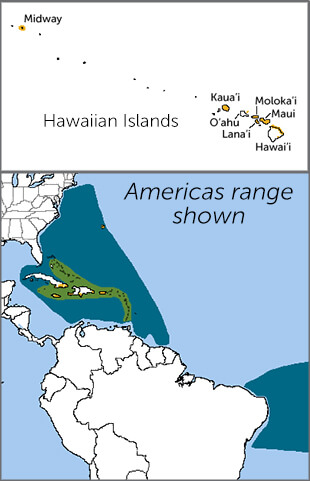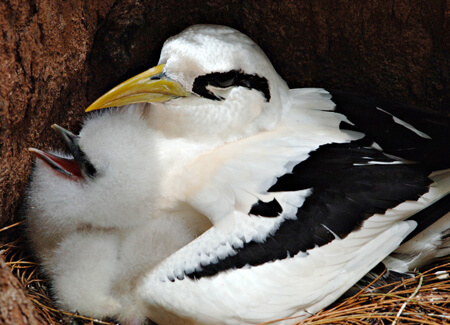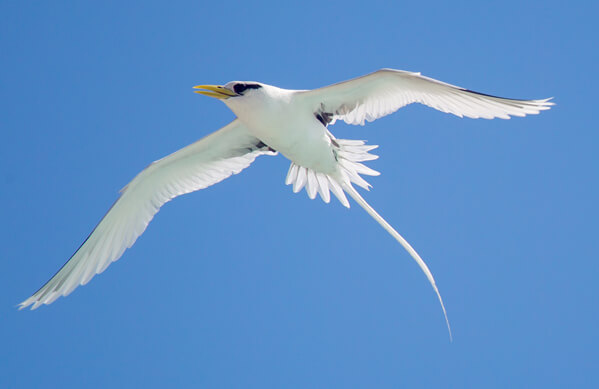 The graceful, streamer-tailed White-tailed Tropicbird is built for life on the wing. Its taxonomic name, Phaethon, is the ancient Greek word for sun and refers to the young charioteer who dared drive the chariot of the sun god high over the ocean.
The graceful, streamer-tailed White-tailed Tropicbird is built for life on the wing. Its taxonomic name, Phaethon, is the ancient Greek word for sun and refers to the young charioteer who dared drive the chariot of the sun god high over the ocean.
The species is widespread in the tropics, found as five subspecies around the world. With long, narrow wings and an aerodynamic shape, this bird can remain in flight for long periods of time; like other pelagic birds such as Laysan Albatross and Great Frigatebird, it comes to land only when nesting.
Sailors sometimes refer to tropicbirds as “bosun” (boatswain) birds because of their shrill, repeated calls, thought to resemble a boatswain's whistle.
Ocean Wanderer
The White-tailed Tropicbird's range encompasses a broad band of tropical and subtropical areas around the world. The birds can be seen from the southern Indian Ocean and western and central Pacific, to tropical and subtropical parts of the Atlantic Ocean and Caribbean. In Bermuda, this beloved tropicbird is known as the "Longtail" and appears on postage stamps and the 25-cent coin.
In the United States, the species is seen mostly on Kaua'i island in Hawai'i, where it is known as Koa'e Kea, and around the Dry Tortugas of Florida. On Kaua'i, most of these tropicbirds nest along steep sea cliffs and sometimes inland in mountain valleys.
Sign up for ABC's eNews to learn how you can help protect birds
Aerial Antics
White-tailed Tropicbirds have a complex aerial courtship in which groups of up to 20 pairs fly in large, vertical circles and patterns while swinging their tail streamers from side to side. Once the male has attracted a mate, pairs break off from the larger group and perform a synchronized, zigzag glide to their nest on a cliff or on a sheltered spot on the ground.

White-tailed Tropicbird and chick. Photo by Reesor Photography, Shutterstock
Hunting by sight, the birds plunge-dive from as high as 65 feet to grab fish, squid, and crustaceans with their serrated beaks. They also nab flying fish while in flight.
Conservation on Sea and Land
Although the White-tailed Tropicbird is widespread and still fairly common, it is threatened in parts of its range. This is particularly true in the Atlantic Ocean and Hawai'i, where habitat loss and introduced species, such as cats, have caused population declines. The hooks and nets of fishing boats snag and drown the birds, while plastic debris and other garbage in the ocean can choke and entangle them.
American Bird Conservancy is working to protect nesting islands for White-tailed Tropicbird and other seabirds such as Newell's Shearwater and Hawaiian Petrel, particularly by using fencing to protect key nesting colonies. We also work to reduce the impact of fisheries by offering educational materials and a web-based mapping tool designed to help fishing fleets avoid accidental bycatch of nontarget species.
Our efforts to bring attention to the problem of outdoor cats and other invasive species have led to a variety of solutions to help keep seabirds (and all birds) safer.
Donate to support ABC's conservation mission!



















































